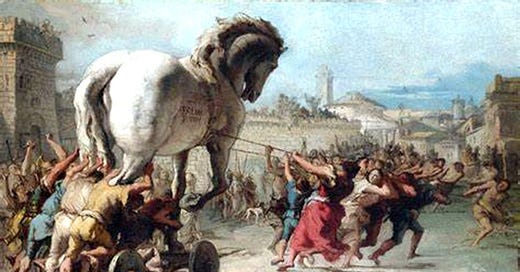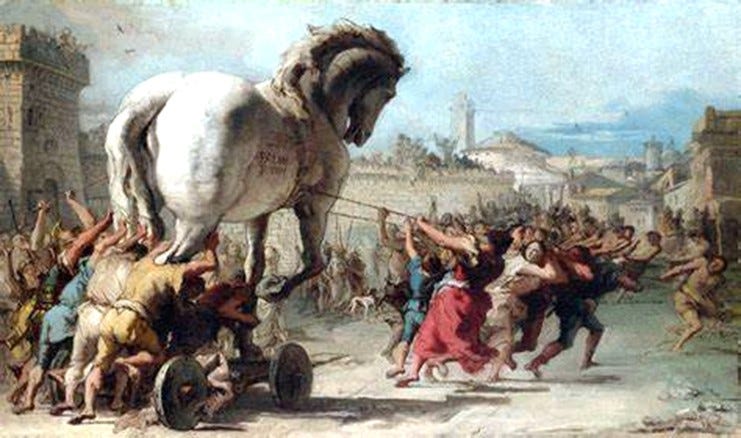This four-part exposé dissects and refines the ideological, financial, and institutional forces driving the Democratic Party’s transformation. It begins with a clear premise: the modern Democratic Party is no longer liberal—it has become a socialist machine, repackaged as “progressive,” and driven by policies, rhetoric, and power structures once confined to the radical fringe.
The modern resurgence of socialism in American politics traces back to the 2018 surprise primary victory of Alexandria Ocasio-Cortez (AOC), a member of the Democratic Socialists of America (DSA). Her win marked a turning point—when Marxist-inspired rhetoric and a radical agenda, once confined to fringe academic circles and activist ecosystems, became the driving force behind the Democratic Party’s agenda.
AOC’s win—amplified by social media and a fawning press—mainstreamed ideas that would have been politically radioactive just a decade earlier. Policies like open borders, mass legalization of illegal immigrants, wealth redistribution, and a Green New Deal-style government-mandated economic restructuring quickly became normalized among party leaders.
The Green New Deal was a Trojan horse—wealth redistribution disguised as climate action, channeling hundreds of billions into ‘equity’ initiatives, social justice NGOs, and unaudited pass-through entities that enriched party activists and amplified leftist propaganda. The Democratic establishment embraced it as a vote-buying scheme to secure and expand one of their most critical voting blocs: people of color. AOC and her progressive allies—the modern socialists—became the heartbeat of the Democratic Party, and the party lurched further left under her ideological lead.
The new Democratic leadership became young, brown, fashionable, and female—embodied by Alexandria Ocasio-Cortez (AOC), the new darling of the liberal-socialist left and the mainstream media that champions its agenda. AOC’s top priority: building a broad-based, “anti-capitalist” movement to advance democratic socialism.
Socialist chic: how the press glamorizes power over principle and substance.
The 2024 election further solidified this ideological realignment. Kamala Harris’s platform, nearly indistinguishable from AOC’s. This level of support for openly progressive governance underscored the power of left-wing propaganda, and the degree to which the party’s base had already absorbed the ideological framework of democratic socialism.
The Progressive Base
The 2024 election confirmed what 2018 foreshadowed: socialism is no longer a fringe influence within the Democratic Party—it’s the main artery. Kamala Harris’s platform, which mirrored AOC’s nearly point for point, received roughly 75 million votes—48.3% of the total electorate. This wasn’t a marginal faction. It was nearly half the country, voting for a candidate running on open borders, climate-driven wealth redistribution, expanded entitlement spending, race-based equity policies, and the normalization of radical social ideology.
Polling for the 2028 Democratic primary reveals even deeper entrenchment. The front-runners now advocate policy platforms that, just a decade ago, would have placed them firmly on the radical far left. Today, those same positions—many lifted directly from the platforms of the Socialist Party USA (85% overlap) and the Communist Party USA (75% overlap)—are considered mainstream within the Democratic leadership.
Here is a snapshot of what unites them:
Open borders and mass legalization of illegal immigrants
Medicare for All and single-payer healthcare
Green New Deal-style economic restructuring
Wealth redistribution and punitive taxation under progressive banners
Racialized redistribution schemes and identity politics
Federalized control of education, childcare, and labor
Court-packing, filibuster elimination, and electoral manipulation
Gun control, union empowerment, and reparations
These are not policy preferences; they are core tenets of a radical lurch to the left—engineered to centralize power, expand government dependency, and permanently entrench Democratic dominance through mass non-citizen voter expansion and a regulatory stranglehold on the economy.
This shared agenda is the product of a decade-long effort to remake the party around a new coalition: younger, more radical, ideologically illiberal, and openly hostile to capitalism, meritocracy, and the constitutional limits on government power.
From Big Tent to Ideological Machine
The Democratic Party was once a broad coalition—a mix of liberals, moderates, labor interests, and minority blocs with competing priorities. That diversity no longer exists at the leadership level. What remains is a top-down ideological machine, where deviation from the progressive-socialist line is treated as heresy—or worse, silence.
Internal dissent has been purged. Democrats who once expressed skepticism about open borders, single-payer healthcare, or massive entitlement expansion have either conformed, retired, or been sidelined. The Overton window hasn’t just shifted—it’s collapsed into a narrow ideological tunnel: state power, group identity, and permanent redistribution.
Today’s rising Democratic leaders don’t debate economic trade-offs or question unintended consequences. They recite mantras: equity over merit, justice over law, identity over citizenship, emotion over evidence. The party’s policy direction is no longer driven by empirical analysis but by ideological loyalty tests enforced through media, academia, and digital echo chambers.
The effect is political uniformity masquerading as diversity—a party that touts representation while silencing dissent, that celebrates pluralism while enforcing orthodoxy. This isn’t progress. It’s soft authoritarianism, wrapped in the language of compassion and fairness, but designed to consolidate control and suppress opposition.
The Real Power Behind the Curtain
The rise of socialism within the Democratic Party didn’t happen organically. It was marketed, funded, and algorithmically amplified by a well-organized system of institutional power. This includes billionaires who finance it, NGOs that launder its messaging, media outlets that protect it, and academic institutions that indoctrinate future foot soldiers.
These elites are not socialists in the traditional sense—they are power brokers. Their goal isn’t economic justice; it’s control. Socialist policies provide the perfect vehicle: they expand the state, weaken the private sector, and centralize authority into the hands of bureaucrats and credentialed class managers. That model serves the ruling elite far better than a dynamic, merit-based free market ever could.
This alliance—between modern socialists and corporate technocrats—has produced a new kind of political machine. It cloaks authoritarianism in empathy, conceals corruption behind identity, and replaces consent with compliance. And it has turned the Democratic Party into a weaponized instrument of ideological warfare.
Billionaire Support: The New Party of the Ultra-Rich
During the 2024 election, Kamala Harris received support from 76 to 83 billionaires, significantly outpacing Donald Trump’s 49 to 52. Her donor base was dominated by tech, finance, and media elites—figures like Michael Bloomberg, Bill Gates, Reid Hoffman, George Soros, and Laurene Powell Jobs—all of whom funneled millions into left-wing causes and Democratic campaigns.
By contrast, Trump, drew support primarily from energy, manufacturing, and traditional finance sectors—the industries most threatened by progressive regulation, ESG mandates, and climate-driven redistribution schemes.
In total fundraising, Harris more than doubled Trump’s haul: $2.1 billion to $1 billion. That disparity reflects a fundamental shift. The Democratic Party—once pitched as the party of the working class—is now the preferred vessel for the ultra-wealthy class of technocrats and institutional power brokers: those who benefit from centralized control, open borders (i.e., cheap labor), regulatory capture, and perpetual narrative management.
Even many of the ultra-rich who support these policies likely don’t grasp their full consequences. For them, it’s often performance art—an act of public alignment designed to fend off activist mobs and social media campaigns that could smear their reputations, disrupt their businesses, or label them as enemies of “equity.” In reality, they’re endorsing an agenda the majority of Americans reject—one that undermines the very system that created their wealth and secured their dominance.
What began with AOC’s primary win in 2018 is no longer a grassroots rebellion. It is now the official operating system of the Democratic Party—an agenda driven by the pursuit of power, not principle, and one whose long-term consequence is the slow dismantling of free enterprise and the unintended erosion of national strength, prosperity, and constitutional order.
In Part II, I’ll expose how this ideological takeover was codified into law—how fringe manifestos have become governing blueprints under banners of climate justice, economic fairness, and state-enforced equity.
Image: The Trojan Horse enters modern politics not through the gates of Troy—but through climate bills, redistribution schemes, and identity politics.






Another great article. The very first statement should open everyone’s eyes.
Isn’t it interesting that no one is talking about the Green New Deal any more, and global warming has become second tier conversation fodder. Trojan Horse indeed. But will we learn from it?